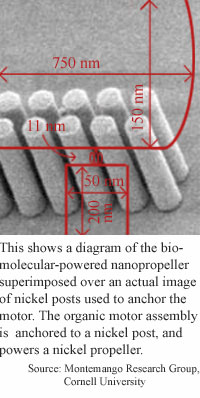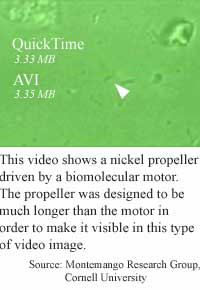
Biomotor powers propeller
By Kimberly Patch, Technology Research NewsReady-made molecular motors have been around for eons in natural systems. The trouble is, these clean, efficient devices are so incredibly small that we haven't been able to use them for anything.
Researchers from Cornell have taken a step toward changing that by combining state-of-the-art abilities in several disciplines to connect a biological motor to a tiny metal propeller.
The device, which may someday lead to molecule-by-molecule drug manufacture, fantastically small sensors, and control of processes inside cells, was made possible by recent advances in several basic sciences, said Carlo Montemagno, associate professor of biological engineering at Cornell University
The 11-nanometer-square biological motor is anchored on a 200-nanometer nickel post, and sports a 750-nanometer-long nickel propeller. The whole device is several times smaller than a red blood cell, which is 5,000 nanometers across. The tiny bits of metal were produced using microelectromechanical systems (MEMS) processes.
The metal devices could have been machined smaller, but the researchers wanted to make the propeller large enough so its motion would show up on a video. "We could have made a 100-nanometer rod, but this is the smallest I can make it and also be able to see it [working]," Montemagno said. The post, in turn, had to be tall enough to support the outsized propeller.
In order to attach the motor to the post, the researchers had to coat an area of the post as small as the motor with a binding material. They also genetically engineered chemical handles at the bottom of the motor so it would attach in the correct orientation.
"We had to be able to orient and bind the motor at the same size scale as the motor itself," said Montemagno. If a mechanic installing a car engine could position the engine only in increments the size of a football field, it would be "really difficult to build a car. The technology had to be mature enough so we could position that motor with precision," he said.
The motor itself is a biological assembly made by a bacterium. Its three double-ringed molecules change adenosine triphosphate (ATP) into adenosine diphosphate (ADP) in the chemical process that universally fuels life. "It's a chemical engine. It takes ATP and hydrolyzes it, converting the ATP into ADP and an extra phosphate molecule... the energy released from having that phosphate release is what powers the motor," Montemagno said.
One turn of the motor produces about 120 piconewtons per nanometer. One newton is about the force of the weight of an apple and a piconewton is one trillionth of that force. The energy released from the three ATP molecules needed to rotate the motor once is actually 240 piconewtons per nanometer, giving the motor a 50 percent efficiency rate. In theory, this could be improved to as much as 80 percent, said Montemagno.
The width of a human hair, at about 75,000 nanometers, is several orders of magnitude larger than the motor. The force produced by one turn of the motor, however, could move a piece of human hair that is several times as long as it is wide.
"This is really the first construct of a post, [biological] motor and a propeller or a swinging element that I have seen," said Steven Kornguth, assistant director of the Institute for Advanced Technology at the University of Texas. "What's new is essentially you have an anchor point for a motor that's... spectacularly small," he said. The device itself is only "a fifth of the size of a red blood cell. That's why it's so tremendously useful," he said.
Because they are so small, biomolecular-powered devices like these could someday be incorporated into living cells or traverse the human bloodstream. "There's two kinds of things this allows us to do," said Montemagno. "It allows us to make... a hybrid system in which you would insert something which is not living into a living system. Or we can take something that's not living, and insert some attributes of a living system. It's like getting Legos and all of a sudden having all the pieces be able to fit together."
Practical applications for the devices are a decade away, Montemagno said.
The first applications are likely to be tiny motor systems for manufacturing drugs or inorganic materials, said Kornguth. Nanotubes, which range from 100 microns to less than one micron in diameter, "can deliver exceedingly small amounts of fluids onto a surface. Here you have a way of moving those fluids at that same scale. A lot of manufacturing is essentially assembly of particles on a surface." These tiny biological motors also produce no heat, which is an advantage in manufacturing because heat distorts surfaces, Kornguth added.
Montemagno's group is working on several projects designed to eventually make the tiny devices practical. First, they need better control of the motor. Currently, it runs until the solution it is suspended in runs out of ATP. "[It's] like having a car that's always on full throttle until it runs out of gas. We're working on putting a switch in the motor so that we can chemically turn [it] on and off," Montemagno said.
The group is also working on making a tiny molecular sorter. "Essentially what it will do is grab onto one molecule and then transport it [to] another location,” he said.
They are also working on powering the motors with light. In addition to using the motors in cellular environments where ATP is ready-made, the motors could be used outside cells and manufacture their own ATP using an artificial photosynthetic process, said Montemagno.
Montemagno's colleagues in the research were Ricky K. Soong, George D. Bachand, Hercules P. Neves, Anatoli G. Olkhovets and Harold G. Craighead, all of Cornell. They published the research in the November 24, 2000 Issue of Science. It was funded by the Defense Advanced Research Projects Agency (DARPA), the National Science Foundation (NSF), the Department of Energy (DOE), NASA, the Office of Naval Research and a W. H. Keck Fellowship.
Timeline: <10 years
Funding: Government; Private
TRN Categories: Nanotechnology
Story Type: News
Related Elements: Image; Video; Technical paper, "Powering an Inorganic Nanodevice with a Biomolecular Motor, Science, November 24, 2000; Additional videos: falcon.aben.cornell.edu/News2.htm
Advertisements:
December 6, 2000
Page One
Biomotor powers propeller
Safe havens offer practical quantum processing
Mechanical data storage goes massively parallel
Frosted nanotubes make metal wires
Interference delivers atomic details


News:
Research News Roundup
Research Watch blog
Features:
View from the High Ground Q&A
How It Works
RSS Feeds:
News
Ad links:
Buy an ad link
| Advertisements:
|
 |
Ad links: Clear History
Buy an ad link
|
TRN
Newswire and Headline Feeds for Web sites
|
© Copyright Technology Research News, LLC 2000-2006. All rights reserved.